The Radium Dance
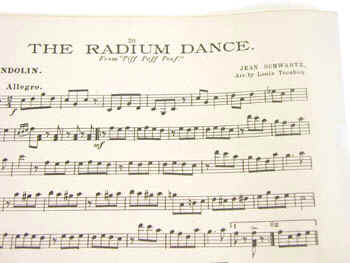
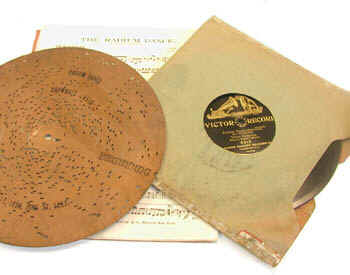
The "Radium Dance" was written by Jean Schwartz for the Broadway musical "Piff, Paff, Pouf." For what it is worth, not very much, pouf was occasionally spelt with a double "f."
The items in the collection pictured here include the sheet music, a perforated metal polyphone disk (a polyphone is akin to a large music box), and a phonograph record.
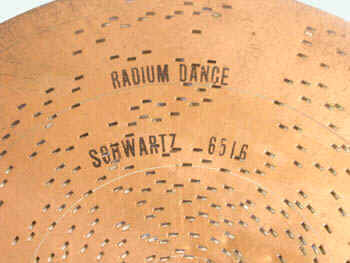
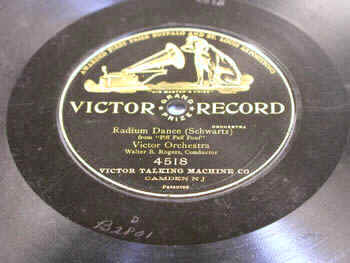
View the entire score. Even better, thanks to the recording kindly provided by Karl Ellison, you can now actually hear the Radium Dance! According to Karl, who plays the piece, this is an "enhanced version" of the score.
The record (10-inch diameter) was produced by the Victor Talking Machine Company of Camden New Jersey. It seems to have been recorded October 12, 1905 in Philadelphia with Walter Rogers conducting the Victor Orchestra (Discography of American Historical Recordings).
The Original Radium Dance
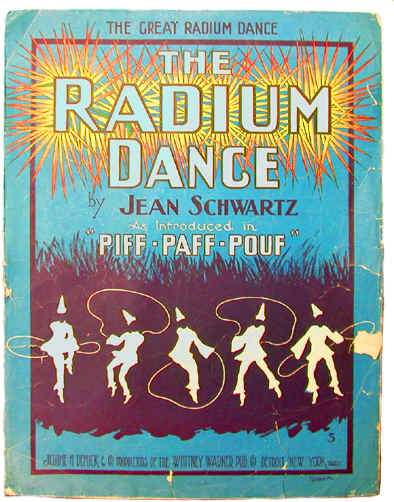
The music sheet cover shows five costumed figures twirling or jumping a rope and glowing in the dark as they do it. This item likely dates from 1904 or 1905.
The original "Radium Dance," a creation of the American Loie Fuller, made its debut in Paris. The earliest reference to it that I have found was a short note in the Rochester Democrat and Chronicle (February 10, 1904):
"Loie Fuller is still up to date. She made a hit with her radium dance. Attired in an absolutely luminous gown, which by a secret and exceedingly clever mechanism flashes forth brilliant phosphorescent rays during her terpsichorean undulations."
More details concerning Fuller's dance were provided in the Buffalo Commercial (March 14, 1904):
"which she has shown to M and Madame Curie. The famous physicists said that the American serpentine lady had made them look upon their own discovery in a new light... No actual salt of radium is manipulated by the lady... the performance, which has not yet been given in public."
This would have been the original "Radium Dance."
Various videos on the web employ the title "Radium Dance," but none of these attempt to recreate the original. However, what is worth seeking out is the original footage of Loie Fuller—this probably gives some idea of what the original dance would have looked like.
The Radium Dance on Tour
Other than the fact that they all employed some sort of glow-in-the-dark effect, I wouldn't expect that the various versions of the "Radium Dance" performed in the United States (including that in Piff, Paff, Pouf) were very similar to Fuller's original version. However, the following statement in the April 6, 1904 issue of the St. Louis Republic vaguely suggests that she might have had some creative input:
"[the Radium Dance] is a European importation that has been secured in Paris for the "Paris on the Pike."
The "Pike" was an entertainment section of the 1904 St. Louis World's Fair. Note that this version of the Radium Dance doesn't seem to be connected to the Jean Schwartz composition in Piff, Paff, Pouf.
By May, the "Radium Dance" was being performed in New Orleans and Atlanta by the "Dixie Troubadours, including Eight English Girls." At the same time, it was also being performed in London—the May 23, 1904 issue of the Guardian described the dance as follows:
"The lights go out, even the orchestral lights,... only visible thing is the conductor's baton which moves like a shoal of glowworms in the abyss. Suddenly appears a row of glowing white figures which might if they had faces be Pierrots; then skirts and bodices and sugar-loaf hats... the ghostly figures move phantastically, separate and intertwine and mingle in strange shapes... The part the audience played was to strike matches in the gallery to see how it was done."
Quoting the Oshkosh Northwestern (July 16, 1904) review of "The Maid and the Mummy" being performed in Chicago's Garrick Theatre:
"the biggest feature of this show is the famous radium dance by the pony ballet. This sensation has never been seen west of New York [not quite true] where it is being used in "Piff, Paff, Pouff" at the Casino. Critics say that this wonderful radium ballot [sic], with its play of lights and electricity, is the most astounding and sensational dance ever seen on any stage."
Despite the occasional claim that the glow-in-the-dark costumes employed radium (Lionel Laurence, San Francisco Chronicle, May 29, 1904), radium was too scarce and valuable in 1904 to have been employed for such a purpose.
The following descriptions of the glow-in-the-dark costumes come from the June 30, 1904 issue of the St. Louis Post-Dispatch:
"these garments are thoroughly saturated with a liquid made from a chemical powder invented by Prof. Giuseppe Bulzano... has the effect of absorbing light, which is brilliantly emitted again... when exposed to artificial light. When the girls don them at night a powerful calcium light is turned upon them thus attired, for at least 10 minutes, and then on the darkened stage the figurantes become veritable storage batteries charged with light."
The Radium Dance in Piff, Paff, Pouf
Despite the somewhat uncertain nature of the aforementioned radium dances, we have a pretty good understanding of what the one in "Piff, Paff, Pouf" looked like. Some idea can be obtained from the picture on the cover of the music sheet seen towards the top of the page, although the English Pony Ballet that performed the dance consisted of eight, not five, dancers.
From the Evening World News (April 4, 1904):
"The stage is darkened, and a phosphorescent light thrown on the dancers dwarfs their figures and turns their big-buttoned Pierrot costumes into dancing dots of red and white... The extraordinary effect is heightened by the nimble , graceful dancers flashing skipping-ropes under their feet and over their heads."
The following description of the "Radium Dance" in "Piff, Paff, Pouf" comes from a review in the New York Times (April 13, 1904):
“The pony ballet dons Pierrot costumes with great disks of phosphorescent substance sewed in them, and on a darkened stage it skips rope with phosphorescent clothes-line.”
After "Piff, Paff, Pouf" ended its run, the same Pony Ballet continued to perform "radium dances" in subsequent productions, e.g., "The Runaways."
Piff, Paff, Pouf, the Musical
"Piff, Paff, Pouf," variously described as "comic opera" or a "musical cocktail," opened April 2, 1904 at the Casino in New York City. The show's creator/writer was Stanislaus Strange, William Jerome wrote the lyrics and Jean Schwartz composed the music.
The show's title refers to three of its leading characters: Lord George Piffle, Macaroni Paffle and Peter Pouffle. The latter was played by Eddie Foy who three months earlier (December 30, 1903) had barely escaped the fire at the Iroquois Theatre by crawling through a sewer. Over 600 people died however.
Although it was not well regarded by many of the critics, the show was popular enough to enjoy an extended run until November 19, 1904. Consider the following reviews:
"Is there nothing but sensuous femininity in Piff, Paff, Pouff?... Much of the play... is stale or else inane in futile attempts to be fresh" (Indianapolis Journal, April 10, 1904)
"Most of Jean Schwartz's music has that where-have-I-heard-it-before sound; and the "book" by Stanislaus Strange is deadly enough to wither the flowers on an Easter hat" (Evening World, April 4, 1904)
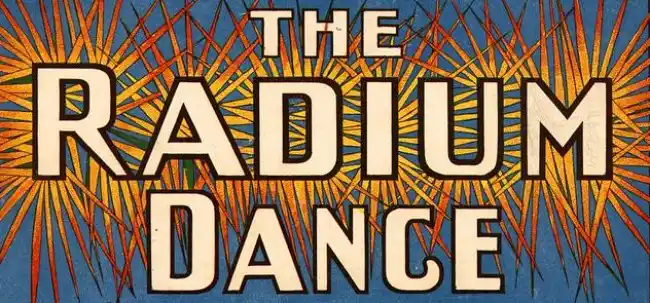
Turn up the tunes: Everything you need to know about the “Radium Dance” located at ORAU’s Museum of Radiation and Radioactivity
Learn about the “Radium Dance” located at ORAU’s Museum of Radiation and Radioactivity, including where the music originated from.
